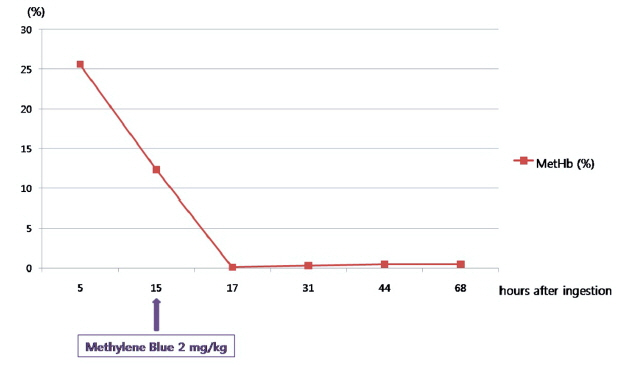Korean J Crit Care Med.
2014 Nov;29(4):341-343. 10.4266/kjccm.2014.29.4.341.
Methemoglobinemia Caused by an Inert Ingredient after Intentional Ingestion of Pesticide
- Affiliations
-
- 1Asan Medical Center, University of Ulsan College of Medicine, Seoul, Korea. schwan97@gmail.com
- KMID: 2227744
- DOI: http://doi.org/10.4266/kjccm.2014.29.4.341
Abstract
- We report two cases of toxic methemoglobinemia caused by an inert ingredient in pesticide product after intentional ingestion of pesticide. First, 51-year-old male visited to the emergency department (ED) after the ingestion of pesticide in a suicide attempt. Initial methemoglobin (MetHb) level was 25.6%. We did not know the cause of methemoglobinemia at that time. Second, 56-year-old female visited to the ED after the ingestion of the same pesticide in a suicide attempt. MetHb level after 30 minutes was 16.1%. The patients were treated with methylene blue. We contacted to the Korean Rural Development Administration and estimated that magnesium nitrate was more likely to cause methemoglobinemia. This report highlights the importance of considering the possibility of methemoglobinemia caused by inert ingredient in pesticide and early antidotal therapy.
Keyword
MeSH Terms
Figure
Reference
-
References
1). Mansouri A, Lurie AA. Concise review: methemoglobinemia. Am J Hematol. 1993; 42:7–12.2). Prasanna L, Rao SM, Singh V, Kujur R, Gowrishankar . Indoxacarb poisoning: an unusual presentation as methemoglobinemia. Indian J Crit Care Med. 2008; 12:198–200.3). Wu YJ, Lin YL, Huang HY, Hsu BG. Methemoglobinemia induced by indoxacarb intoxication. Clin Toxicol (Phila). 2010; 48:766–7.
Article4). Park JS, Kim H, Lee SW, Min JH. Successful treatment of methemoglobinemia and acute renal failure after indoxacarb poisoning. Clin Toxicol (Phila). 2011; 49:744–6.
Article5). Jin K. Rhabdomyolysis, methemoglobinemia and acute kidney injury after indoxacarb poisoning. Clin Toxicol (Phila). 2012; 50:227.
Article6). Cox C, Surgan M. Unidentified inert ingredients in pesticides: implications for human and environmental health. Environ Health Perspect. 2006; 114:1803–6.
Article7). Centre for Science of Athabasca University. Magnesium Nitrate Material Safety Data Sheet. Athabasca University;[Lab Reagents Database]. 2005. Oct. [2005 Oct ]. Available from http://science.pc.athabascau.ca/reagentstud.nsf/0/f8e65efce32b16c2872570920065283b/$FILE/Magnesium%20nitrate%20hexahydrate%20MSDS.pdf.8). Wright RO, Lewander WJ, Woolf AD. Methemoglobinemia: etiology, pharmacology, and clinical management. Ann Emerg Med. 1999; 34:646–56.
Article9). Skold A, Cosco DL, Klein R. Methemoglobinemia: pathogenesis, diagnosis, and management. South Med J. 2011; 104:757–61.10). Groeper K, Katcher K, Tobias JD. Anesthetic management of a patient with methemoglobinemia. South Med J. 2003; 96:504–9.
Article11). Clifton J 2nd, Leikin JB. Methylene blue. Am J Ther. 2003; 10:289–91.
Article
- Full Text Links
- Actions
-
Cited
- CITED
-
- Close
- Share
- Similar articles
-
- Fatal Propanil Pesticide Poisoning Presenting with Methemoglobinemia
- Risk Factors to Predict Acute Respiratory Failure in Patients with Acute Pesticide Poisoning
- Case of Acute Methemoglobinemia Caused by Nitrobenzene Ingestion
- Risk Factors to Predict Acute Respiratory Failure in Patients with Acute Pesticide Poisoning
- A Patient with "Rebound Methemoglobinemia" during Treatment of Methemoglobinemia Caused by Propanil Intoxication



